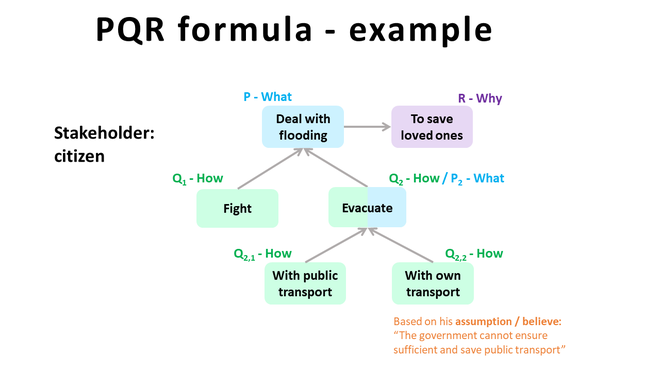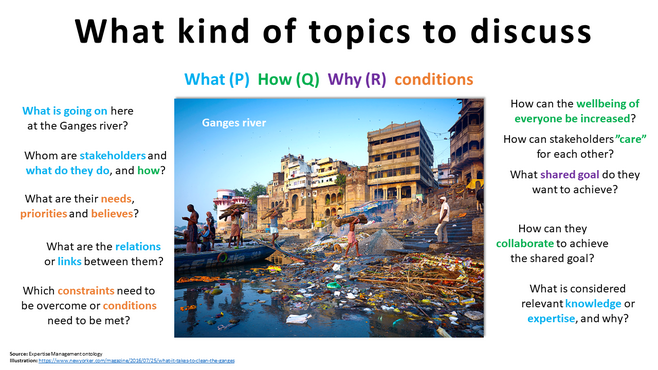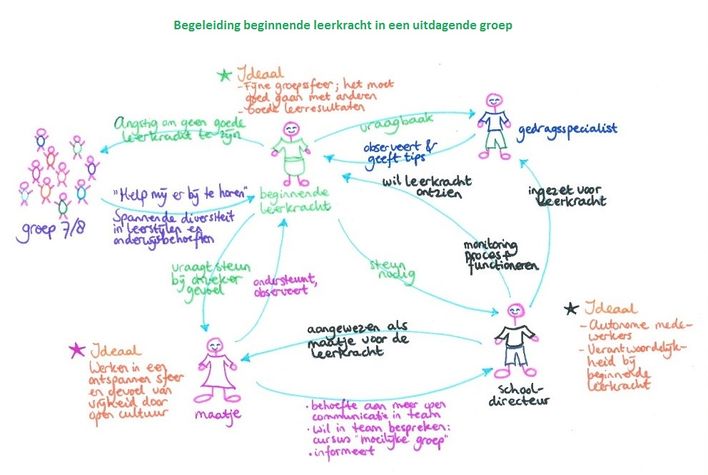LC 00576: verschil tussen versies
Geen bewerkingssamenvatting |
Geen bewerkingssamenvatting |
||
| Regel 20: | Regel 20: | ||
'''5./1. Als Facilitator of Change help je de betrokkenen''' '''naar een proces van ‘co-evolutie’ te gaan''' (samen doen → samen leren → samen doen → samen leren, etc.). Een behulpzame vraag daarbij is “Doen we gezamenlijk ‘de juiste dingen’ voor en met betrokkenen in hun sociale en fysieke omgeving, en wat menen we dat deze ‘juiste dingen’ zijn?” | '''5./1. Als Facilitator of Change help je de betrokkenen''' '''naar een proces van ‘co-evolutie’ te gaan''' (samen doen → samen leren → samen doen → samen leren, etc.). Een behulpzame vraag daarbij is “Doen we gezamenlijk ‘de juiste dingen’ voor en met betrokkenen in hun sociale en fysieke omgeving, en wat menen we dat deze ‘juiste dingen’ zijn?” | ||
=== Met betrokkenen in gesprek gaan === | ==== Met betrokkenen in gesprek gaan ==== | ||
====Voorbereiding==== | =====Voorbereiding===== | ||
*Identify the stakeholders you want to interview (introduce yourself and the aim of the interview / your Living Lab) | *Identify the stakeholders you want to interview (introduce yourself and the aim of the interview / your Living Lab) | ||
*Make a topic list with help of PQR and other open questions (also based on current literature) | *Make a topic list with help of PQR and other open questions (also based on current literature) | ||
=====Gespreksonderwerpen===== | ======Gespreksonderwerpen====== | ||
*Voorbeelden van onderwerpen die je in gesprek met betrokkenen kunt bespreken: het (gezamenlijke) doel; wat zijn ‘de goede dingen’ om te doen; wie en wat hoort er bij dit vraagstuk of zou er bij betrokken moeten worden, en wie/wat niet; wat wordt rondom dit vraagstuk beschouwd als relevante bronnen (waarom?), etc. | *Voorbeelden van onderwerpen die je in gesprek met betrokkenen kunt bespreken: het (gezamenlijke) doel; wat zijn ‘de goede dingen’ om te doen; wie en wat hoort er bij dit vraagstuk of zou er bij betrokken moeten worden, en wie/wat niet; wat wordt rondom dit vraagstuk beschouwd als relevante bronnen (waarom?), etc. | ||
*The context (‘system boundaries’) of the situation (or when the context is broadened: what if…?) | *The context (‘system boundaries’) of the situation (or when the context is broadened: what if…?) | ||
| Regel 58: | Regel 58: | ||
Boundary categories and questions make explicit the everyday judgements on which we rely (consciously or not, {{Internal link|link=LC 00488|name=blinde vlekken|dialog=process-linkpage-dialog}}) to understand situations, get new perspectives and to identify and design desired improvements (gebaseerd op Critical Systems Heuristics). Meer lezen? Zie: {{Cite|resource=Bestand:31.pdf|name=Kritische systeemtheorie|dialog=process-file-dialog}} door Hans De Bruin, in ''Meer dan de som der delen,'' pagina's 555-569.[[Bestand:Ulrich grensoordelen.png|gecentreerd|miniatuur|546x546px|'''Figuur X:''' Grensoordelen (Ulrich, 2000)|koppeling=https://projectenportfolio.nl/wiki/index.php/Bestand:Ulrich_grensoordelen.png]][[Bestand:Vragen voor duurzame en wenselijke verandering.png|gecentreerd|miniatuur|888x888px|'''Figuur X:''' Vragen voor duurzame en wenselijke verandering.|koppeling=https://projectenportfolio.nl/wiki/index.php/Bestand:Vragen_voor_duurzame_en_wenselijke_verandering.png]] | Boundary categories and questions make explicit the everyday judgements on which we rely (consciously or not, {{Internal link|link=LC 00488|name=blinde vlekken|dialog=process-linkpage-dialog}}) to understand situations, get new perspectives and to identify and design desired improvements (gebaseerd op Critical Systems Heuristics). Meer lezen? Zie: {{Cite|resource=Bestand:31.pdf|name=Kritische systeemtheorie|dialog=process-file-dialog}} door Hans De Bruin, in ''Meer dan de som der delen,'' pagina's 555-569.[[Bestand:Ulrich grensoordelen.png|gecentreerd|miniatuur|546x546px|'''Figuur X:''' Grensoordelen (Ulrich, 2000)|koppeling=https://projectenportfolio.nl/wiki/index.php/Bestand:Ulrich_grensoordelen.png]][[Bestand:Vragen voor duurzame en wenselijke verandering.png|gecentreerd|miniatuur|888x888px|'''Figuur X:''' Vragen voor duurzame en wenselijke verandering.|koppeling=https://projectenportfolio.nl/wiki/index.php/Bestand:Vragen_voor_duurzame_en_wenselijke_verandering.png]] | ||
====Tijdens het gesprek==== | =====Tijdens het gesprek===== | ||
'''Begin with an open mind, not an empty head''' | '''Begin with an open mind, not an empty head''' | ||
*Introduce yourself and the aim of the interview; ask for permission to record the interview; explain how you will use (and maybe anonymize) the results | *Introduce yourself and the aim of the interview; ask for permission to record the interview; explain how you will use (and maybe anonymize) the results | ||
| Regel 122: | Regel 122: | ||
*Data transcription & analyses | *Data transcription & analyses | ||
* | *Li | ||
<accesscontrol>Access: We got to move</accesscontrol> | <accesscontrol>Access: We got to move</accesscontrol> | ||
nk resul | |||
| Regel 133: | Regel 135: | ||
research to current situations | research to current situations | ||
*Conduct more interviews until a saturation point is reached | *Conduct more interviews until a saturation point is reached | ||
====Het vraagstuk analyseren, structureren en inzichtelijk maken==== | =====Het vraagstuk analyseren, structureren en inzichtelijk maken===== | ||
*Cluster answers to your questions according to the conversation topics | *Cluster answers to your questions according to the conversation topics | ||
*FoC’s jointly discuss interpretations of the conversations (and identify synergies, challenges, conditions, etc.) | *FoC’s jointly discuss interpretations of the conversations (and identify synergies, challenges, conditions, etc.) | ||
| Regel 159: | Regel 161: | ||
Andere technieken zijn: Purposeful Activity Models (PAM), maar ook andere technieken, zoals bijvoorbeeld System Dynamic (SD) models | Andere technieken zijn: Purposeful Activity Models (PAM), maar ook andere technieken, zoals bijvoorbeeld System Dynamic (SD) models | ||
====Joint interpretation and validation==== | =====Joint interpretation and validation===== | ||
*Validating interpretations and visualizations with stakeholders involved | *Validating interpretations and visualizations with stakeholders involved | ||
**Ensure stakeholders recognize themselves in the initial interpretation / visualisation (= the reason to use their quotes) | **Ensure stakeholders recognize themselves in the initial interpretation / visualisation (= the reason to use their quotes) | ||
| Regel 166: | Regel 168: | ||
*Coalition of the willing to jointly find desired improvements: the circle of (new) stakeholders increases: a constructive ‘bedding’ has been developed (plenary discussions are no longer a ‘wrestling championship’ of the FoC alone). | *Coalition of the willing to jointly find desired improvements: the circle of (new) stakeholders increases: a constructive ‘bedding’ has been developed (plenary discussions are no longer a ‘wrestling championship’ of the FoC alone). | ||
*These conversations gradually evolve into the ‘broad dialogue’ with institutions about governance and ethical starting points (which in turn will result in (new) strategy and execution to experiment with “doing the right things and doing those things right”) | *These conversations gradually evolve into the ‘broad dialogue’ with institutions about governance and ethical starting points (which in turn will result in (new) strategy and execution to experiment with “doing the right things and doing those things right”) | ||
===Aanverwante methoden, technieken en repertoire=== | ====Aanverwante methoden, technieken en repertoire==== | ||
*Appreciative Inquiry: het waarderende gesprek | *Appreciative Inquiry: het waarderende gesprek | ||
*''Boundary crossing technique (Carla Oonk)'' | *''Boundary crossing technique (Carla Oonk)'' | ||
Versie van 20 nov 2020 14:05
- Stappen
- Wat vraagt het van de ander en van jezelf als FoC
- Oefeningen
- Goede voorbeelden
- Link met competenties FoC
Het proces
Om tot breed gedragen oplossingen te komen, kun je met elkaar een proces doorlopen dat is geïnspireerd op de Soft Systems Methodology. Verderop staan aanwijzingen hoe je vorm kunt geven aan elke fase in dit proces:
1. Ga met betrokkenen in gesprek om hun wereldbeelden (perspectieven) over het vraagstuk helder te krijgen. Voer de gesprekken vanuit oprechte aandacht: het zich gehoord voelen is namelijk een van de sterkste behoeften van betrokkenen. Gesprekken zijn dus een van de beste dingen - interventies - die je als Facilitator of Change voor dit soort vraagstukken kunt doen.
2. Analyseer, structureer en maak het vraagstuk inzichtelijk. Je analyseert de gesprekken en beeldt de betrokkenen, hun onderlinge relaties of verbanden, en issues (visueel) overzichtelijk uit.
3. Organiseer gesprekken met en tussen de betrokkenen over hoe iedereen in het vraagstuk staat en wat volgens hen daarvoor mogelijke oplossingen zijn. Organiseer validatiesessies en benut het (visuele) overzicht uit fase 2 daarvoor.
Fasen 1, 2 en 3 wisselen elkaar af - ze verrijken elkaar - totdat er verzadiging optreedt en dus wederzijds begrip ontstaat.
4. Betrokkenen implementeren samen de breed gedragen en wenselijke oplossingen. Voeg geleerde lessen toe aan een Body of Knowledge and Skills, opdat deze benut kunnen worden in toekomstige, soortgelijke situaties.
5./1. Als Facilitator of Change help je de betrokkenen naar een proces van ‘co-evolutie’ te gaan (samen doen → samen leren → samen doen → samen leren, etc.). Een behulpzame vraag daarbij is “Doen we gezamenlijk ‘de juiste dingen’ voor en met betrokkenen in hun sociale en fysieke omgeving, en wat menen we dat deze ‘juiste dingen’ zijn?”
Met betrokkenen in gesprek gaan
Voorbereiding
- Identify the stakeholders you want to interview (introduce yourself and the aim of the interview / your Living Lab)
- Make a topic list with help of PQR and other open questions (also based on current literature)
Gespreksonderwerpen
- Voorbeelden van onderwerpen die je in gesprek met betrokkenen kunt bespreken: het (gezamenlijke) doel; wat zijn ‘de goede dingen’ om te doen; wie en wat hoort er bij dit vraagstuk of zou er bij betrokken moeten worden, en wie/wat niet; wat wordt rondom dit vraagstuk beschouwd als relevante bronnen (waarom?), etc.
- The context (‘system boundaries’) of the situation (or when the context is broadened: what if…?)
- Goal, purpose, ambitions, desires, (ethical) starting points of the stakeholder
- What + How? Activities or processes (executed or needed, you recognize them because regularly they are expressed with verbs)
- Conditions of the context (present or needed) (the extent to which something is present, often expressed in ‘degrees’)
- Beliefs and preconditions (that are present)
- Systemic principles: systems want to be complete, exchange, have an intrinsic order, being connected with their source and aim to achieve a ‘purpose’ (source: Hellinger Institute)
- Very often recognition, connection, being heard, clarity and identity / cultural history are important topics or needs of the stakeholder.
- “Hoe doen we de dingen goed?” (verificatie) en “Hoe doen we gezamenlijk de goede dingen, en wat zijn die goede dingen dan?” (validatie) gaan hand in hand en zijn onderdeel van het iteratieve proces.
Gespreksonderwerpen met behulp van de PQR-formule
- P = What (activity)
- Q = How (more specific activity)
- R = Why (goal, ambition, desire, etc.)
Do P (What) by Q (How) in order to achieve R (Why). Example: Deal with a flooding by evacuating in order to save loved ones.
Q (How) are activities executed under certain (which?!) circumstances/ conditions or based on the stakeholders’ assumptions/believes.
Oefening: De PQR-formule toepassen
Goal: Experience how you can try to understand the worldviews of the stakeholders and how they are related to each other
Instructions
1. Choose a situation in your Living Lab and choose a stakeholder
2. Discuss and write down the PQR’s for this stakeholder in a diagram
- Do the same for other stakeholders
- Look whether there are links between or overlap with their P’s, Q’s or R’s
3. Go to the ‘meeting room’ for your Living Lab in this Teams channel
4. After this exercise: plenary sharing and reflecting at experiences and lessons learned
Grensoordelen
Boundary categories and questions make explicit the everyday judgements on which we rely (consciously or not, blinde vlekken) to understand situations, get new perspectives and to identify and design desired improvements (gebaseerd op Critical Systems Heuristics). Meer lezen? Zie: Kritische systeemtheorie door Hans De Bruin, in Meer dan de som der delen, pagina's 555-569.
Tijdens het gesprek
Begin with an open mind, not an empty head
- Introduce yourself and the aim of the interview; ask for permission to record the interview; explain how you will use (and maybe anonymize) the results
- Ask your questions and make notes (or let a team mate make them – agree on your roles)
- Ask more in-depth questions (use PQR) as the conversation progresses
- To really understand the stakeholder you should be able to give all your attention to him or her – the conversation lasts approximately 1,5 hours
- Take some time to let the ‘interviewee’ trust you. Start with small talk or ask him or her to describe a typical “day of your (work)life”. Become aware of stories with an emotional load. You can use these as indicators to later on talk about it (after they have gained trust in you – roughly after 15 minutes). You need to be very discrete with this matter.
- Be aware of your own intentions as an ‘interviewer’. Roles: one who leads the conversation, the other takes notes silently
- Silence is, among other things like nodding, a very helpful probe to talk about relevant topics
- While identifying win-win improvements you can present the views of other stakeholders
- Having conversations to identifying win-win improvements is an iterative process
- Practice, practice, practice and develop your own style (take leadership in this)
- Find more information here: https://www.projectenportfolio.nl/wiki/index.php/LC_00097. About responsive methodology: https://www.projectenportfolio.nl/wiki/index.php/LC_00335
Carefully observe what you hear or say:
Speaking "non-violently" (with a focus on connecting with others)
- Wanting to connect to search for opportunities and solutions
- (Empathetically) observing, understanding and clearly expressing what is needed
- Asking for action or connection
- Allowing “No” as an answer and asking why that is the case
- Daring to make mistakes
Speaking "violently"
- Being afraid to loose connection, being competitive and hostile
- Interpreting, judging, mistunderstanding
- Criticizing, complaining, blaming
- Forcing, manipulating and attacking others
Finish the conversation
- Close with some small talk (no abrupt ending after a serious conversation) and make sure everyone is happy with the conversation
- Ask for contact details to follow-up (e.g. sending notes for verification) and for recommended other stakeholders to interview as well
- Thank the interviewee for his / her cooperation
Oefening: Conversation between FoC & stakeholder
Goal: experiencing the explication of worldviews - both as interviewer and as stakeholder
Instructions
- Choose a challenging situation from your Living Lab you want to practice with
- Divide roles: stakeholder, FoC (interviewer), observer(s)
- Interview between Facilitator of Change and stakeholder (role play)
- FoC (interviewer): use the topics of slide 11 (adjust for your situation) and interview tips of slide 13
- Stakeholder (interviewee): asnwer with waht you know about the stakeholder, if not: say what comes to your mind (play the role, don’t close the conversation with: “I don’t know what the stakeholder thinks / wants / etc.”
- Finish the interview with short observations by all of you – the interviewer, interviewee, observers
- ± 3 rounds | amount of time: 10 minutes per interview | rotate roles: same or new t
opic Etiquette:
just experience it, no right/wrong, respect, confidentiality, take a short time-out if needed, and attitude: openness, vulnerability, discomfort, playfulness
After this exercise: plenary sharing and reflecting at experiences and lessons learned.
Deze oefening kun je uitbreiden door gesprekken met meerdere betr
okkenen te oef
enen, bijvoorbeeld om ge
zamenlijk te leren of voor validatiesessies. ====Gesp
rekken uitwerken====
- Data transcription & analyses
- Li
Dit is een beveiligde pagina.
nk resul
ts from
research to current situations
- Conduct more interviews until a saturation point is reached
Het vraagstuk analyseren, structureren en inzichtelijk maken
- Cluster answers to your questions according to the conversation topics
- FoC’s jointly discuss interpretations of the conversations (and identify synergies, challenges, conditions, etc.)
- Collect relevant and lively quotes. FoC (most likely is the only one who) knows sensitive issues of stakeholders
- Visualize results and relations between stakeholders: rich picture, infographic, conceptmap. Tip: use colors, shapes, etc. to give meaning to the different elements)
- Whom (and what) are involved and affected by your project?
- Try to describe per stakeholder / aspect (make specific):
- What is their goal, wish or need related to the project topic?
- How do they already contribute to solving the problem?
- What do they need from others (whom?) or contribute to solve the problem?
Zie ook: https://www.projectenportfolio.nl/wiki/index.php/LC_00097
Rijke plaatjes maken
- Doel: Samen begrijpen voor ingrijpen.
- Nut: Met behulp van het praatplaatje krijg je het vraagstuk beter in beeld en kunnen betrokkenen met elkaar in gesprek gaan en samen zoeken naar betekenisvolle verbeteringen.
- Belangrijkste onderdelen:
- De betrokkenen en hun rol in de situatie.
- Hun wensen, doelen en/of ideale rol in de situatie.
- Hun onderlinge relaties. Wat brengen zij en krijgen zij van anderen?
- Relevante en sprekende quotes.
- Aanvullende informatie en theorie.
- Vereiste: Het plaatje spreekt voor zich en de betrokkenen herkennen zich er in.
Nalopen: https://www.projectenportfolio.nl/wiki/index.php/LC_00861
Andere technieken zijn: Purposeful Activity Models (PAM), maar ook andere technieken, zoals bijvoorbeeld System Dynamic (SD) models
Joint interpretation and validation
- Validating interpretations and visualizations with stakeholders involved
- Ensure stakeholders recognize themselves in the initial interpretation / visualisation (= the reason to use their quotes)
- Ensure stakeholders are willing to understand each other (this willingness likely increases as they already felt heard during the individual conversation with FoC)
- Facilitator of Change knows sensitive issues and carefully anticipates on these
- Coalition of the willing to jointly find desired improvements: the circle of (new) stakeholders increases: a constructive ‘bedding’ has been developed (plenary discussions are no longer a ‘wrestling championship’ of the FoC alone).
- These conversations gradually evolve into the ‘broad dialogue’ with institutions about governance and ethical starting points (which in turn will result in (new) strategy and execution to experiment with “doing the right things and doing those things right”)
Aanverwante methoden, technieken en repertoire
- Appreciative Inquiry: het waarderende gesprek
- Boundary crossing technique (Carla Oonk)
- Consent methode
- “De meedogenloze schoonheid van de samenleving” door Jan Jacob Stam
- Deep Democracy
- Gesprekstechnieken (boekjes, handleidingen - opm. Kees B)
- Geweldloze Communicatie; Communikaartjes Verbindende Communicatie van Ai-opener
- IKH guide en gespreksonderwerpen (ws 4 minor FF): https://www.projectenportfolio.nl/wiki/index.php/LC_00335
- “In dialoog” door Kees Voorberg en Eelco de Geus
- Multi Stakeholder Participation
- Omdenken; Ja Maar
- Open Space Technology
- Oplossingsgericht gesprek
- Socratisch gesprek
- Systemisch gesprek / Rake vragen / Opstellingen
- Systemisch werk / systemische principes
- The Work (door Byron Katie)
- Ubuntu
- …
- Literatuur IL MRDD
- Boekje RH-DHV





